Mole Control
There are many methods of mole control — less than adequate strategies and methods, as well as old wives’ tales. There are also some methods that provide some results, but not the best results. We provide two different methods of control: baiting and trapping.
Whatever method is employed, baiting or trapping, rest assured that it is performed by professional mole control experts when you choose Flying Pig Pest Control to rid your lawn of moles.

Mole baiting is a method by which we identify active mole tunnels and strategically and effectively place bait that will be found by moles that are traveling through the lawn and landscape. Utilizing this method, no traps are in the way of mowers.
Mole trapping is the most measurable method of mole control in that when a mole is trapped, you actually get a “head count” (literally)! We make regular visits to your property to check traps, placing the proper amount of traps, depending on the current level of activity.
When you contact us, we will explain the pros and cons of each method and help you decide which method is right for you. If you have a preference for a particular method, we are glad to oblige!
Call or Text Us (513) 993-5455 or Send Us a Message / Get a Quote
The Process
Mole control is a process that often takes time, patience, and persistence. There are no proven methods that can keep moles from entering your lawn; they can enter any time throughout the year. Therefore, mole control is reactive in the sense that they must be dealt with when they enter the property. However, Flying Pig Pest Control takes a proactive approach in that we make regular return visits, aggressively attacking moles in order to minimize damage and to rid your lawn of the little underground terrors.
Moles can enter the property throughout the year, even after the property has been mole-free for some time. They construct tunnels that the moles may or may not re-use. There are active tunnels, which moles use most often. Moles that travel in the active tunnels often do so on a daily basis.
There are also probing tunnels — tunnels moles construct, usually in search for food — that they may never re-enter. Each time we visit your property to control moles, we look for the active tunnels. Identifying the active tunnels, as well as providing control when new mole tunnels present themselves is the purpose of each visit we make.
Bottom line: our decades of mole control experience, along with regular visits, results in controlling the moles in your lawn.

How Our Service Works
Initially, we make an appropriate number of bait placements or set an appropriate number of traps, depending on which method is utilized.
- We return on a regular basis and identify the active tunnels, placing bait or traps that moles will find as they use the tunnel regularly.
- You will receive an email service report after each visit, letting you know the service details of your visit. If you do not receive the emails, please check your spam/junk folders and move them to your inbox. If that does not work, please call us so that we can make sure you are able to receive your reports.
- We continue to make regular service visits until you no longer want or need the service. Sometimes weather (such as snow and frozen ground conditions) and other conditions may result in stretching out the visits beyond a week.
- You are not obligated to sign a contract for a full year. While some properties need mole control year-round, most of them do not. Many of our clients save money because we employ our services only as moles enter their properties. Others enjoy the peace of mind knowing that Flying Pig Pest Control monitors their lawn throughout the year. You also have the option of year-round protection for your property with our annual program. This program is recommended for those whose properties typically have a significant amount of moles in their property throughout the year.
Call or Text Us (513) 993-5455 or Send Us a Message / Get a Quote
Related: Mole Damage In Lawns: What to Look For
Mole FAQs
Here are some answers to common mole questions.
Which method of mole control is best?
For the longest time, trapping has been considered the best method of mole control. Many other methods and wives’ tales have developed, giving less than favorable results. Poisoned peanuts, mole “chasers,” chewing gum, glass, and repellents all fall short of effectively controlling moles.
Additionally, there has not been, until recent years, an effective mole bait. Today, we have found that baiting can be an effective method of control when applied properly — especially by an experienced mole control professional. The bait we use mimics the mole’s natural food source – the earthworm. As moles travel active tunnels, they find and consume the bait.
Trapping, the “tried and true” method, has long been the best way to control moles. It is the most measurable method of control.
Baiting moles has gained both popularity and success in recent years. The bait can be expensive, but it is less labor-intensive to apply. When baiting for moles, there are no traps to mow around, and it is less invasive.
How many moles are in my lawn?
The number of moles present in lawns can vary greatly; there is no formula for determining how many moles might inhabit a lawn. Where mole activity is found, there is often more than one mole present. Oftentimes, more moles are present than most people anticipate. A female produces 2-6 young per litter in the spring. Moreover, multiple families can be present nearby, adding to the problem.
How long will I need your service?
There are several factors that come into play here — the extent of mole activity, the size of your lawn, number of moles present, environment, time of year, weather, and new mole activity — as well as many other factors that play a role in mole eradication. Therefore, it is impossible to say how long the service will be needed.
Many of our clients need the service for a short amount of time (i.e. a few weeks) if they have a smaller infestation. Others, who have larger lawns in areas where moles are more prevalent, may need mole control all season long. A typical scenario (note that this is typical, not a guarantee) that we have seen is that a client needs mole control for a month or two, then does not need the service for some time. Moles (in this scenario) may return in the future. Our clients then call us back to resume service.
For this reason, we do not require long-term contracts. For others, though, a long-term agreement makes sense — and may save them money in the long run.
If trapping the moles, where do you place the traps? How many traps will you set?
We make regular service visits with the goal of identifying active mole tunnels. Active tunnels are the tunnels that moles will use on a regular basis, while probing tunnels are created by moles and used rarely, maybe only once.
It’s similar to looking at a road map that contains many different roads, including interstate highways, state routes, and rarely traveled areas such as township roads. By identifying the “interstate” tunnels and placing traps on them, we trap more moles, resulting in better/quicker results.
We are great at identifying active tunnels. However, identifying these tunnels also requires some “trial and error” during the process. This is why we make multiple visits approximately a week apart.
If baiting for moles, where is the bait placed and how many bait placements are made?
The concept is similar to trapping in that an appropriate number of bait placements is made. Most importantly, we must follow all state and federal laws when placing bait. The number of bait placements we make is determined by the amount of mole activity. We make regular service visits with the goal of identifying active mole tunnels. We apply bait in the active tunnels.
What Do Moles Eat?
Moles primarily eat earthworms. Moles are also known to eat white grubs and other insects, but the vast majority of their diet consists of earthworms.
Grub control may be a good way to protect your lawn from grub damage, but is not an effective method of mole control.
Cicadas: In the Cincinnati area, we see different broods of the 17-year cicada. As the cicada nymphs grow in the soil, they become an ample source of protein for moles. As a result, females produce more young in their litters. This is why many homeowners experience a significant amount of mole activity leading up to the years when the periodic cicadas emerge.
The bottom line is that moles love big, juicy worms! Since this is the case, they always have something to eat.
Is there something I can do to help identify active tunnels?
Yes! By stomping down a tunnel (or a portion of a tunnel), you will know if the tunnel is active if it reemerges. When moles re-use the “stomped down” tunnel, they will push the soil back up. This is how you know that the tunnel is active.
Before calling us to set up service, we encourage homeowners to first stomp down all the tunnels in their lawn. If there is no activity, we suggest that you wait before starting service, which could save you money. If, however, the tunnels reemerge, then it’s time to call Flying Pig Pest Control.
Can the traps harm my children or pets?
They certainly can if children or pets tamper with them, so keep them away! Traps can be dangerous if they are pulled out of the ground. They can also be dangerous if a child sticks his or her hand down in the tunnel under the trap.
Pets are rarely harmed by the traps. As a matter of fact, we have never had a client’s pet harmed by a trap yet. A dog, for example, would have to dig at just the wrong angle in order to trap its paw, therefore it is rare that a dog would be harmed. However, it can (even though it is rare) happen!
Do moles hibernate? Do I need mole control in the winter?
Moles can be active in the winter as well.

Moles do not hibernate and are active all year round. In colder seasons, such as winter in the Cincinnati area, moles will tunnel deeper when the surface of the ground is frozen, but they still move around. Moles typically follow the food source, which is mostly earthworms. In the winter, when the ground is frozen, the earthworms tunnel deeper in the soil, where moles follow.
Trapping moles in the winter can be effective, especially since they mate in the spring. While mole activity slows down in the winter, trapping moles in the winter can help prevent them from having babies in the spring. After all, dead moles cannot reproduce!
